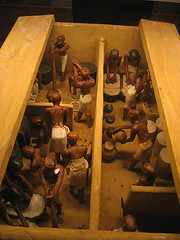
Ancient Egyptian model of workers brewing beer, New York Metropolitan Museum
Originally uploaded by miguel c
Pharaonic basics: bread & beer
The mouth of a perfectly contented man is filled with beer.
Inscription dating to 2200 BCE
Beer, henqet (Hnq.t) [8], was the preferred drink of humans and gods, of rich and poor, of grown-ups and children. In the Instructions of Ani: the mother sent you to school when you were ready to be taught writing, and she waited for you daily at home with bread and beer.
Papyrus Chester Beatty IV
Bread and beer were the basic foodstuffs, and while most people had some difficulty making ends meet, there was—among the better-off at least—the danger of overindulging, and educators were aware of it. In the Instructions of Kheti the student is warned:
When you have eaten three loaves of bread and swallowed two jugs of beer, and the body has not yet had enough, fight against it.
the Instructions of Kheti
Beer, together with bread, oil and vegetables, was an important part of the wages workers received from their employers. The standard daily ration during pharaonic times was two jars containing somewhat more than two litres each. It was a healthier drink than water drawn from the river or some canal, which was often polluted.
The Egyptians liked their beer cool as can be learned from a complaint against some robbers who had stolen some food and drink:
They drew a bottle of beer which was [cooling] in water, while I was staying in my father's room.




No comments:
Post a Comment